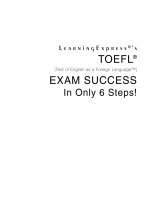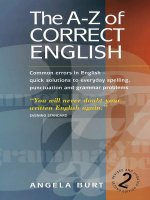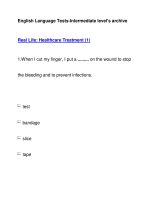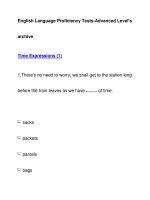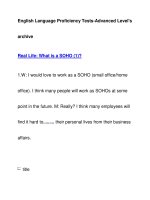Success step english 1 potx
Bạn đang xem bản rút gọn của tài liệu. Xem và tải ngay bản đầy đủ của tài liệu tại đây (157.02 KB, 6 trang )
88
1. Read the graph carefully. Read all around the graph, including the title and the key.
2. Some questions may try to trick you by leaving out numbers. If all the numbers are not given, it is a very good
idea to fill in all the missing numbers on the graph. To do this, you will need to know the value of each
increment.
3. Sometimes, instead of reading bars or lines, you can compare differences by using a piece of your test book-
let to measure from one point to another or from the end of one bar to the end of another.
Line Graphs
3. In what year is the increase in student popula-
tion projected to be less than the increase in
number of new homes built?
a. 1998
b. 1999
c. 2000
d. 2001
e. 2002
Answer
The answer is c. A look at the graph shows that during
the year 2000 there was a sharper increase in the num-
ber of new homes built than in student population.
The line slopes up steeper there for houses than it does
for student population. Percent of increase is a differ-
ent question and might yield a different answer. Check
Ratios, Proportions, and Percents (p. 109) on percents
for details.
Picture Graphs
4. How many MTAC members were there in 1990?
a. 3
ᎏ
1
2
ᎏ
b. 350
c. 700
d. 1,750
e. 2,250
Answer
It is important to read the key at the bottom of the
graph. Each piano represents 500 members.
ᎏ
1
2
ᎏ
a piano
represents 250 members. 1990 has 3
ᎏ
1
2
ᎏ
pianos. This rep-
resents 1,750 members. The answer is d.
Three Success Steps For Working With Graphs
Circle Graphs
5. For which category was the income for the Save
the Caves Foundation approximately
ᎏ
1
4
ᎏ
?
a. Mailings
b. Sales
c. Thrift Shop
d. Phone
e. Other
Answer
Look for the section that takes up approximately
ᎏ
1
4
ᎏ
of
the circle. The answer is a.
Here’s a different kind of circle graph question.
6. Which of the following could include a represen-
tation of expenditures of 25% and 33%?
Answer
25% is the same as
ᎏ
1
4
ᎏ
. 33% is close to
ᎏ
1
3
ᎏ
. The only
answer with areas of
ᎏ
1
4
ᎏ
and
ᎏ
1
3
ᎏ
of the circle is answer d.
Choice b is close, but the larger area seems a little large
for
ᎏ
1
3
ᎏ
.
e.
d.
c.
b.
a.
–CBEST MINI-COURSE–
89
Oddballs
Some graphs are just plain odd.
7. The circles above represent the dials on an elec-
tric meter. What reading do they represent?
a. 476
b. 465
c. 466
d. 486
e. 487
Answer
There are no clues whatsoever on the graphs. A look at
the answer choices reveals that all are three digits and
that all begin with the digit 4. Maybe each circle rep-
resents a digit. If so, the first dial has to represent 4. If
the first dial represents 4, and the arrow is nearly half-
way around (assuming the dials go clockwise), then
half is probably 5. In that case, the last circle represents
5, which tells you your answer, choice b. It makes sense
that the middle digit of 465 is 6, since the middle cir-
cle’s arrow goes just a bit past the 5 mark. In order to
correctly answer this question, it was important that
you didn’t assume the graphs represent clocks. Ques-
tions similar to this have been on the test before.
All right, here’s a challenge.
8. Which number best represents the speed indi-
cated on the speedometer above?
a. 12
ᎏ
1
2
ᎏ
b. 30
ᎏ
1
2
ᎏ
c. 35
d. 40
ᎏ
1
2
ᎏ
e. 45
Answer
It is very important to label the graph in order to
answer this question. If there are 11 segments between
10 and 120, each segment must represent 10 mph. The
arrow is pointing halfway between 30 and 40. Halfway
between 30 and 40 is 35. The answer is c.
Math 1: Words, Words, Words
Many times, an otherwise simple problem may seem
difficult merely because the test writers have used
terms that you are not familiar with. An understand-
ing of mathematical terms will enable you to under-
stand the language of the problem and give you a
better chance of solving that problem. This lesson
presents a list of words used when speaking about
numbers.
Here is a sample question that will show you why
knowing these words is important. Once you’ve
learned the words in this sample question, you should
be able to answer it.You can check your answer against
the explanation given later in this lesson.
–CBEST MINI-COURSE–
90
Sample Definition Question
1. If x is a whole number and y is a positive integer,
for what value of x MUST x < y be true?
a. −3
b. 0
c.
ᎏ
1
2
ᎏ
d. 3
e. Any value of x must make the statement true.
Definitions
Below are definitions of words you need to know to
answer CBEST math questions. If some of these words
are unfamiliar, put them on flash cards: the word on
one side, and the definition and some examples on the
other side. Flash cards are handy because you can carry
them around with you to review at odd moments dur-
ing the day. If you use this method, it won’t take you
long to learn these words.
Integer
An integer is simply a number with no fraction or dec-
imal attached {. . . −2, −1, 0, 1, 2 . . .}. Integers include
both negative (−5) and positive (9,687) numbers. Zero
is also an integer, but is considered neither negative nor
positive in most mathematical texts.
Positive Integer
A positive integer is an integer, according to the defi-
nition above, that is greater than zero. Zero is not
included. Positive integers begin with 1 and continue
infinitely {1, 2, 3 . . .}. Examples of positive integers are
5, 6,000 and 1,000,000.
Negative Integer
A negative integer is an integer that is less than zero.
Zero is not included. The highest negative integer is
negative one (−1). The negative integers go down infi-
nitely {. . . −3, −2, −1}. Some examples of negative inte-
gers are −10, −8, −1,476. The following numbers do
not fit the definition of a negative integer: −4.5 (not an
integer because of the decimal), 0, and 308.
Zero
Zero is an integer that is neither positive nor negative.
Whole Numbers
Whole numbers include all positive integers, as well as
zero {0, 1, 2, 3 . . .}. Like integers, whole numbers do
not include numbers with fractions or decimals.
Digit
A digit is a single number symbol. In the number
1,246, each of the four numerals is a digit. Six is the
ones digit, 4 is the tens digit, 2 is the hundreds digit, and
1 is the thousands digit. Knowing place names for dig-
its is important when you’re asked on a test to round
to a certain digit. Rounding will be covered in the third
math lesson.
Real Numbers
Real numbers include all numbers: negative, positive,
zero, fractions, decimals, most square roots, and so on.
Usually, the numbers used on the CBEST will be real
numbers, unless otherwise stated.
HOT TIP
Negative numbers appear smaller when they are larger. To
help you make sense of this concept, think of the degrees
below zero on a thermometer. Three degrees below zero
is hotter than 40 degrees below, so −3 is greater than −40,
even though 40 appears to be a larger number. Test mak-
ers like to test your grasp of this principle.
–CBEST MINI-COURSE–
91
Variables
Variables are letters, such as x and y, that are used to
replace numbers. The letter is usually a letter of the
alphabet, although occasionally, other symbols are
used. When a math problem asks you to “solve for y,”
that means figure out what number the letter is replac-
ing. At other times, the problem requires you to work
with the letters as if they were numbers. Examples of
both of the above will be covered in the lesson on
algebra on page 114.
Reciprocal
The reciprocal of a fraction is the fraction turned
upside down. For example, the reciprocal of
ᎏ
3
8
ᎏ
is
ᎏ
8
3
ᎏ
and
vice versa. The reciprocal of an integer is one over the
integer. For example, the reciprocal of 2 (or
ᎏ
2
1
ᎏ
) is
ᎏ
1
2
ᎏ
and
vice versa. To get the reciprocal of a mixed number
such as 3
ᎏ
1
2
ᎏ
, first change the number to an improper
fraction (
ᎏ
7
2
ᎏ
) and then turn it over (
ᎏ
2
7
ᎏ
).
Numerator and Denominator
The numerator of a fraction is the number on top, and
the denominator is the number on the bottom. The
numerator of
ᎏ
6
7
ᎏ
is 6 and the denominator is 7.
= and
The symbol = is called an equal sign. It indicates that
the values on both sides of the = are equal to each
other. For example, 7 = 2 + 5.A line drawn through an
equal sign (≠) indicates that the values on either side
are not equal: 8 ≠ 4 + 5.
Ͻ and Ͼ; Յ and Ն
The symbol < means less than and the symbol > means
greater than. The number on the closed side of the
symbol is smaller, and the number on the open side is
larger. Thus, 3 < 5 and 10 > 2. Remember: The alliga-
tor eats the bigger number.
The symbol ≤ means less than or equal to, and the
symbol ≥ means greater than or equal to. These two
symbols operate the same way as the < and >, but the
added line means that it’s possible that the two sides
are equal. Thus, in the equation x ≥ 3, x can represent
3 or any number greater than 3.
Answer to Sample Definition Question
Using the definitions above, can you solve sample
question 1 from the previous page? The variable x can
be any whole number including zero. The variable y
can be any positive integer, which doesn’t include zero.
The question reads “ for what value ofx MUST x <
y be true?” Must means that x has to be less than y
under all circumstances. You are being asked to replace
x with a number that will be less than any positive inte-
ger that replaces y. The only whole number that would
make x < y true, no matter what positive integer is put
in place of y, is zero. Therefore, b is the correct answer.
Try another sample question. Again, the defini-
tions above will be useful in solving this problem.
Sample Digits Question
2. In a certain two-digit number, the tens digit is
four more than the ones digit. The sum of the
two digits is ten. What is the number?
a. 26
b. 82
c. 40
d. 37
e. 73
–CBEST MINI-COURSE–
92
Answer
There are two requirements for the unknown number:
The tens digit has to be four more than the ones digit,
and the two digits have to add up to 10. The best way
to solve the problem is to eliminate answers that don’t
meet these two requirements. Consider the second cri-
terion first. A glance at the answers shows that the dig-
its in the answers a and c do not add up to 10. They can
be eliminated. Next, consider the first requirement.
Answer b contains a tens digit that is six, not four,
more than the ones digit. Answer d has the ones digit
four more than the tens, reversing the requirement.
Therefore, e is the only number that correctly meets
the requirements.
Practice with Definitions
Match the word on the left with the description or
example on the right. You may want to write these def-
initions on flash cards.
Answers
Math 2: Numbers Working
Together
In the last lesson, you learned the definitions of several
mathematical terms. This lesson will discuss ways in
which numbers work together. You will need this
information to solve simple algebra and perform cer-
tain arithmetic functions that will be part of some
CBEST problems.
Adding and Subtracting Integers
The following sample questions are examples of the
types of problems about adding and subtracting you
may see on the CBEST. The answers are given later in
this lesson.
Sample Integer Questions
1. Every month, Alice’s paycheck of $1,500 goes
directly into her bank account. Each month,
Alice pays $800 on her mortgage payment and
$500 for food and all other monthly expenses.
She spends $1,650 per year on her car (insur-
ance, gas, repairs, and maintenance), $500 per
year for gifts, and $450 per year for property tax.
What will be her bank balance at the end of a
year?
a. $500
b. $300
c. 0
d. −$200
e. −$400
3. e.
4. c.
5. f.
6. a.
7. b.
8. g.
9. i.
10. h.
11. k.
12. j.
13. d.
__ 3. integer
__ 4. whole number
__ 5. zero
__ 6. negative integer
__ 7. positive integer
__ 8. digit
__ 9. <
__ 10. >
__ 11. ≤
__ 12. ≥
__ 13. real number
a. { −3, −2, −1}
b. {1, 2, 3 . . .}
c. {0, 1, 2, 3 . . .}
d. number set includ-
ing fractions
e. {. . . −3, −2, −1, 0, 1,
2, 3 . . .}
f. neither negative nor
positive
g. one numeral in a
number
h. greater than
i. less than
j. greater than or equal
to
k. less than or equal to
–CBEST MINI-COURSE–
93

